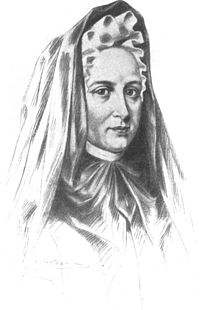Unlike the anchorites such as Zuster Bertken or Julian of Norwich, Jeanne Marie Bouvier de La Motte Guyon, most commonly known as Madame Guyon, was imprisoned involuntarily. But her works that resulted from her imprisonment still bring comfort and insight to many today. This may be especially so for those of us pent up from pandemic or otherwise. Her influence was felt throughout Europe. Many great spiritual leaders said they were indebted to her for the spiritual lessons of her life and writings.
Jeanne Marie Bouvier de La Motte was born in 1648 to a wealthy family south of Paris. She was of delicate health and spent her time between the convent and the home of religious parents who gave her pious training. That training included study of St. Francis de Sales, Madame de Chantal and Thomas a Kempis. These studies, along with the sentiment of espousal with Christ, drove her to become a nun, but her parents forbade it. In 1664, she was forced into an arranged marriage to a wealthy gentleman, Jacques Guyon, 22 years her senior and in poor health. The marriage was unhappy, but short. Guyon died in 1676 when Jeanne Marie was 28. In the interim, she gave birth to five children of whom three survived to adulthood. She lived quietly as a rich widow, but in 1679 she resumed her religious studies. After several mystical experiences she was persuaded by the Bishop of Geneva to use her money to set up a house for “new Catholics” in Savoy, part of plans to convert Protestants. While there, she clashed with the sisters in the house and the Bishop sent Father La Combe to intervene. La Combe introduced her to the mysticism of interiority. Thereafter, she renounced her personal possessions, except for an annuity. The Bishop asked her to leave and expelled Father La Combe. She returned to Grenoble France where she spread her doctrine with her book, A Short and Easy Method of Prayer. This work is not lengthy and can be found easily on the internet. The local bishop asked her to leave the city. Again, she moved, this time to Paris, where she acquired a following for her mystical theories. King Louis XIV disliked her mysticism and imprisoned her in a convent in 1688. She was released seven months later at the urgings of an influential convert in the king’s court, Madame de Maintenon, who agreed with Guyon’s doctrine of pure and disinterested love of God. Guyon’s opinions were condemned by a commission, but she continued to publish. She was imprisoned again, and ultimately ended up in the Bastille, staying there from 1698 to 1702. After release, she spent life in retirement with her daughter until her death in 1717. Her writings fill 40 volumes.
So what was it that got her in such hot water with the church? The Quietist Movement. Quietism is a set of beliefs that were popular in France, Italy and Spain at this time, but condemned as heresy by Pope Innocent XI. The church claimed quietism wrongly elevated contemplation over meditation and intellectual stillness over vocal prayer. She wrote of absorption of the soul, reduced to nothing, and complete passiveness. Her life and writings emphasized the Holy Spirit. It resembled the Quaker movement and the original Friends were sometimes called Quietists. It refers to quiet submission to God and the Holy Spirit.
She wrote extensively while imprisoned, and this included 900 spiritual songs. They were composed to ballad tunes. Today, several are still found in mostly American hymnals. “Amour que mon ame eat contente” was translated by William Cowper as “My Lord, How Full of Sweet Content” and based on the lyrics, reflects her periods of imprisonment and banishment.
My Lord, how full of sweet content
I pass my years of banishment.
Where’er I dwell, I dwell with Thee,
In Heaven, in earth or on the sea.
To me remains nor place nor time
My country is in every clime.
I can be calm and free from care
On any shore, since God is there.
While place we seek, or place we shun
The soul fins happiness in none.
But with a God to guide our way,
‘Tis equal joy, to go or stay.
Could I be cast where Thou are not,
That were indeed a dreadful lot.
But regions none remote I call,
Secure of finding God in all.

